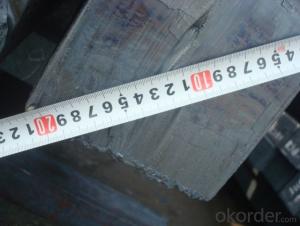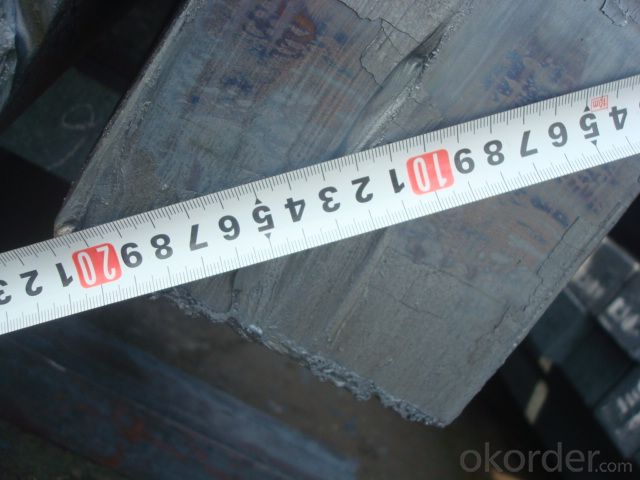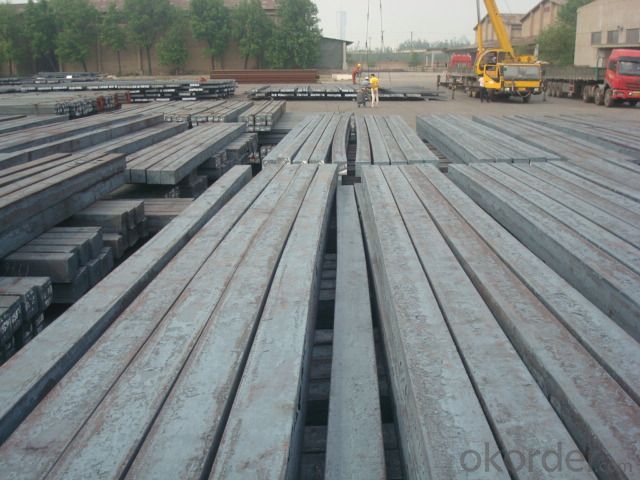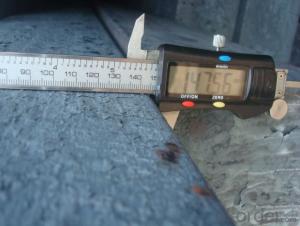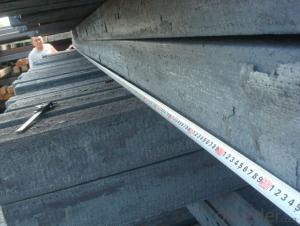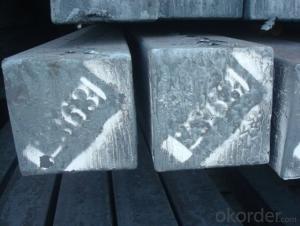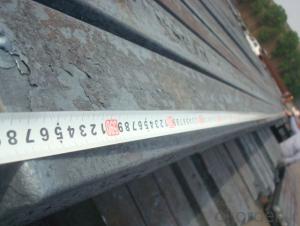Continue Casting Steel Billets Manufactured by Blasting Furnace
- Loading Port:
- Tianjin
- Payment Terms:
- TT OR LC
- Min Order Qty:
- 1000 m.t.
- Supply Capability:
- 100000 m.t./month
OKorder Service Pledge
OKorder Financial Service
You Might Also Like
Continue Casting Steel Billet by Blasting Furnace
1.Structure of Continue Casting Steel Billet by Blasting Furnace
Continue Casting Steel Billet by Blasting Furnace is the raw material of all kinds of steel mill. Billet section of square, round, flat, rectangular and abnormity, etc Several, mainly related to shape of rolled products. Simple rolled section steel, choose cross section of square billet or rectangular billet. rolling The sector products such as flat steel, Angle steel, select the rectangular billet or slab. Had better profiled billet when production beams, channels, and in rolling process Lines and improve the yield. The raw material of round billet is the production of seamless tube.
2.Main Features of Continue Casting Steel Billet by Blasting Furnace.
Continue Casting Steel Billet by Blasting Furnace section size should meet the requirements of rolling deformation and finished product quality, but also roll strength and biting condition of restrictions. General steel Billet section height H. And the roll diameter D The ratio of the ( namely H/D) Should be less than or equal to zero 0.5 . Length of steel billet by finishing temperature, Rolling time and the length of the product Or times ruler.
3. Continue Casting Steel Billet by Blasting Furnace Images
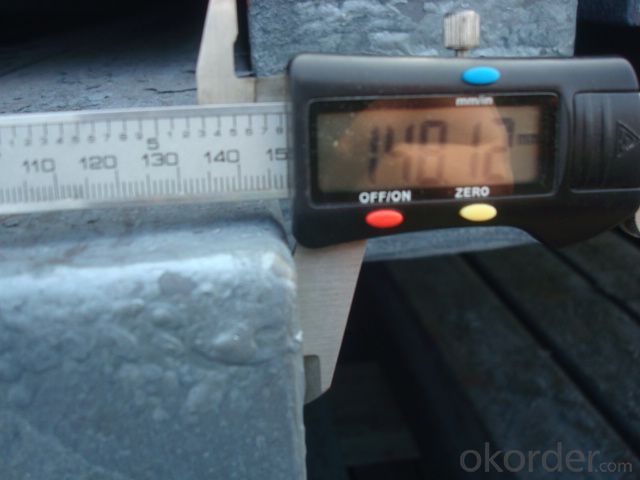
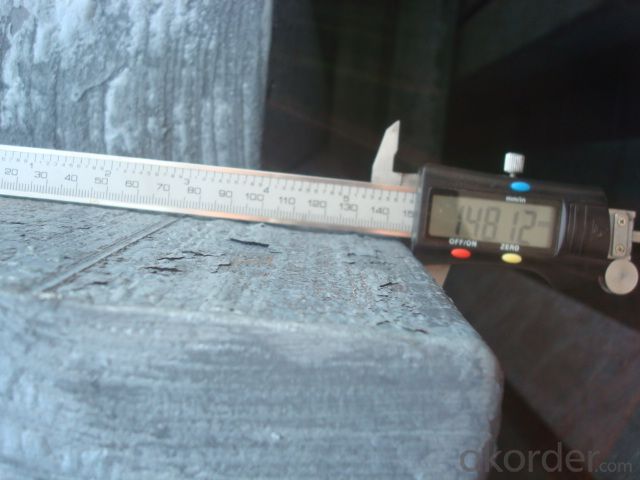
4. Continue Casting Steel Billet by Blasting Furnace Specification
Continue Casting Steel Billet by Blasting Furnace rolled steel, after processing can be used for mechanical parts, forging parts, processing all kinds of steel, steel Q345B channel steel, wire rod is the role of the billet. Steel billet is used in the production of semi-finished products, generally cannot be used directly for the society. Steel billets and steel are strictly divided into standard, cannot decide to whether the business enterprise of the final product, and according to unified standards to perform the whole society. Typically, billet and the steel is relatively easy to distinguish, but for some steel billet, and have the same specification and same steel purposes (such as rolling tube billet), whether can be used for other industries, whether through steel processing process, whether through a finished product rolling mill processing to distinguish
5.FAQ of Continue Casting Steel Billet by Blasting Furnace
We have organized several common questions for our clients,may help you sincerely:
①What kinds of the quality problem the continue casting billet may have?
1)Slab of purity(Inclusion quantity, shape, distribution, etc); (2)The surface of the casting defects(Cracks, slag inclusion, porosity, etc); (3)Slab internal defects(Crack, segregation, inclusion, porosity and shrinkage cavity, etc). Slab of purity depends mainly on molten steel into the mold before processing,Namely before pouring molten steel make "clean";Cast to the control process at the same time, don't let the inclusions with steel downward.
②What is the quality problem of the continuous casting billet? The quality of final steel products depends on the quality of casting billet.The quality of casting billet refers to get qualified steel products is allowedThe severity of the casting defects. We care about, what the quality problem of the continuous casting billet can be addressed by electromagnetic stirring, this will certainly involve the quality problems.
When casting to the control process, don't let the inclusions with steel downward. Slab of purity control starts () electric furnace and converter smelting to refining outside the furnace, tundish metallurgy, protective casting and electromagnetic stirring process control of the whole process. Slab surface defect is mainly depends on the solidification process of molten steel in mould, its shell in the mould forming process, mould liquid level fluctuation, the submerged nozzle design, protective slag performance and other factors.Must control the parameters affecting the quality of the surface within the target value, thus producing zero defect of slab, which is the precondition of hot delivery and direct rolling. Slab internal defects including internal cracks, porosity and shrinkage cavity, mainly depends on the slab cooling process in secondary cooling area and slab support system.Reasonable secondary cooling water distribution, backup roll for, prevent slab such as drum belly is the premise to improve internal quality of slab.Slab internal elements segregation, which is related to the whole process. , therefore, in order to obtain good casting quality can according to the different requirements of steel grade and products, in the different stages of continuous casting, such as the ladle, tundish, mold and secondary cooling zone using different techniques, including electromagnetic stirring, effectively control the quality of casting billet.
③How is the quality affect the rolling producing?.
General rolling process using billet continuous casting billet,Rolling billet and forging stock,Basically on the billet steel rolling productionAll have the same requirements,From the steel chemical composition,Overall dimensions,Billet surface and internal qualityRequirements. The requirement of steel grade and chemical composition First should comply with the relevant standard gauge billet grades and chemical compositionDecide,For different types of steel on the content of residual elements in steel have corresponding requirements,But these requirements is to ensure that wireRequired by the quality.Especially I personally think for rolling mainly to chemical composition to uniform Of course, more than the harmful elements,Or gas content is much,Will be unable to save the consequences in the rolling.forThe shape of the billet size requirements are:The cross section shape and allowable deviation of steel,Specified length.The shortest length of short feetAnd proportion, bending, torsion, etc. These requirements are considered the rolling mill production ability into full play,Guarantee for billet heating and rolling smoothly and considerThe comprehensive factors such as the possibility and rationality of certain
- Q: How are steel billets used in the production of structural steel?
- Structural steel production relies heavily on steel billets, which are indispensable for the manufacturing process. These semi-finished steel products serve as the initial material, from which the transformation begins. To initiate the production of structural steel, scrap steel is melted in a high-temperature furnace. Once the steel reaches its liquid state, it is poured into molds that give it a solid, rectangular shape with a uniform cross-section. After the billets solidify, they are transported to a rolling mill. In this facility, the billets are reheated to a specific temperature and passed through a series of rollers. With each pass, the billets progressively undergo size and shape reduction. This crucial step, known as hot rolling, refines the mechanical properties of the steel. The hot-rolled billets then proceed to various techniques, including forging, extrusion, or casting, to achieve specific shapes and sizes required for structural applications. These techniques enable the transformation of the billets into beams, columns, plates, or other components necessary for construction projects. Once the desired shape is attained, the structural steel undergoes several treatments to enhance its strength, durability, and resistance to corrosion. Heat treatment, surface coating, and additional alloying elements may be employed for this purpose. Ultimately, the finished structural steel products find application in a wide range of projects, including the construction of buildings, bridges, and infrastructure. The consistent size and shape of the steel billets ensure that the resulting components possess the necessary strength, stability, and structural integrity to withstand the loads and stresses they will encounter. In conclusion, the importance of steel billets in structural steel production cannot be overstated. They serve as the fundamental material that undergoes various processes to achieve the desired shapes and sizes required for construction. The quality and uniformity of the billets are paramount in ensuring the strength and durability of the final structural steel products.
- Q: Can steel billets be used in the production of construction machinery?
- Yes, steel billets can be used in the production of construction machinery. Steel billets are semi-finished products that can be further processed to manufacture various components and parts required in construction machinery. These billets provide a reliable and strong material, making them suitable for the construction industry's heavy-duty applications.
- Q: How are steel billets heated for rolling?
- To prepare steel billets for rolling, they undergo a process known as billet heating or billet reheating. This involves subjecting the billets to high temperatures, making them more malleable and easier to shape during rolling. Various methods can be used to heat steel billets for rolling. One commonly employed technique involves the utilization of a walking beam furnace. Here, the billets are positioned on a conveyor that moves them through a furnace. The furnace is heated to a specific temperature, typically ranging from 1100 to 1250 degrees Celsius, and the billets are exposed to this heat for a predetermined duration. Continuously moving the billets through the furnace ensures uniform heating. Another method for billet heating involves the use of a rotary hearth furnace. In this approach, the billets are placed on a rotating hearth, which is heated by burners located beneath it. As the billets rotate on the hearth, they gradually absorb the heat emitted by the burners, gradually reaching the desired temperature. Induction heating is also a popular option for billet heating. This method employs an induction coil to generate an alternating magnetic field. The billets are placed within the coil, and the magnetic field induces electrical currents within them, resulting in the billets heating up. Induction heating is renowned for its efficiency and precise temperature control. Once the steel billets attain the desired temperature, they are ready for the rolling process. The heated billets are then transferred to a rolling mill, where they undergo further processing and shaping into various forms, such as bars, rods, or sheets. The heating process is crucial, as it enhances the ductility of the steel billets, minimizing the risk of cracking or failure during rolling.
- Q: How are steel billets used in the production of wind turbine components?
- Steel billets are used in the production of wind turbine components by being heated and shaped into various parts such as shafts, gears, and frames. These billets serve as the raw material that is later machined, welded, and assembled to create robust and durable components for wind turbines.
- Q: How do steel billets contribute to the manufacturing of aerospace components?
- Steel billets play a crucial role in the manufacturing of aerospace components. These billets are semi-finished products that are used as a starting material in the fabrication of various aerospace parts. One of the primary ways steel billets contribute to the manufacturing of aerospace components is through their versatility. Steel is known for its exceptional strength, durability, and resistance to corrosion, making it an ideal material for aerospace applications. Billets made from high-quality steel provide the necessary foundation for the production of components that can withstand the extreme conditions experienced during aerospace operations. Steel billets are often used in the production of critical aerospace parts such as engine components, landing gear, structural frames, and fasteners. The billets are first heated and then subjected to various forming and machining processes. These processes, such as forging, rolling, and extrusion, help shape the steel billets into the desired components, ensuring they meet the stringent requirements for strength, precision, and weight reduction demanded by the aerospace industry. Moreover, steel billets offer excellent design flexibility. They can be easily machined and shaped into complex geometries, allowing manufacturers to create intricate aerospace components with precise tolerances. This flexibility enables the production of lightweight yet strong parts, contributing to the overall weight reduction of aircraft and enhancing fuel efficiency. Furthermore, steel billets offer superior metallurgical properties. Through proper heat treatment and alloying techniques, the mechanical properties of the steel can be tailored to meet specific aerospace requirements. This allows manufacturers to achieve the desired balance between strength, stiffness, and toughness in the final components, ensuring they can withstand the high-stress environments encountered in aerospace applications. In conclusion, steel billets are an indispensable part of the manufacturing process for aerospace components. Their versatility, strength, design flexibility, and metallurgical properties make them an ideal starting material for the production of critical parts in the aerospace industry. By utilizing steel billets, manufacturers can ensure the production of high-quality, reliable, and durable components that meet the rigorous demands of the aerospace sector.
- Q: How are steel billets tested for strength?
- Steel billets are tested for strength using various methods to ensure their quality and suitability for different applications. One of the commonly used tests is the tensile strength test. In this test, a sample of the steel billet is subjected to a controlled pulling force until it breaks. The maximum force applied during this test determines the tensile strength of the billet. Another important test is the hardness test, which measures the resistance of the steel billet to indentation. This test is performed using a hardness tester, which applies a known force onto the surface of the billet and measures the depth of the resulting indentation. The hardness value obtained from this test helps determine the billet's strength and ability to withstand wear and tear. In addition to these tests, steel billets may also undergo impact testing, where a pendulum is swung to strike the billet, measuring the amount of energy absorbed during fracture. This test helps assess the billet's toughness and ability to withstand sudden shocks or impacts. Furthermore, ultrasonic testing is often conducted to detect any internal defects or inconsistencies within the steel billet. This non-destructive testing method uses high-frequency sound waves to identify any hidden flaws, such as cracks, voids, or inclusions, which could weaken the billet and compromise its strength. Overall, a combination of these tests and other quality control measures ensures that steel billets are thoroughly tested for their strength and suitability for various industrial applications, such as construction, automotive, and manufacturing.
- Q: What are the typical dimensions and weight of steel billets?
- The specific dimensions and weight of steel billets can differ depending on the requirements of the industry or application. However, as a general rule, steel billets are rectangular and have a length that is several times greater than its width and height. The width of steel billets usually falls within the range of 100mm to 200mm, while the height typically ranges from 100mm to 300mm. In terms of length, steel billets can measure anywhere between 3,000mm and 6,000mm. These dimensions may vary depending on the particular use, as different industries may have specific demands for their steel billets. In regards to weight, steel billets typically weigh anything from a few hundred kilograms to several metric tons. The weight is influenced by multiple factors, including the dimensions, density, and grade of steel utilized. It is vital to note that steel billets can be tailored to meet specific weight requirements, especially in industries such as construction, automotive, and manufacturing, where precise weight specifications are indispensable. In summary, the dimensions and weight of steel billets can fluctuate based on industry needs, but they generally maintain a rectangular shape and can range from a few hundred kilograms to several metric tons.
- Q: Billet prices skyrocketing weekend, Southern China steel prices rose?
- So, three month contract period, even transportation during two days, there will be a big money and lose big reversal.
- Q: What are the main factors affecting the surface roughness of steel billets?
- The main factors affecting the surface roughness of steel billets include the quality of the raw materials used, the manufacturing process, the condition of the equipment used, and the skill and expertise of the operators.
- Q: What are the common heat treatment processes for steel billets?
- There are several common heat treatment processes for steel billets. These processes are used to alter the mechanical properties of the steel, such as its hardness, strength, and toughness, to meet specific requirements for different applications. One of the most common heat treatment processes for steel billets is annealing. This involves heating the steel to a specific temperature and holding it at that temperature for a certain period of time, followed by slow cooling. Annealing helps to relieve internal stresses in the steel, improve its machinability, and enhance its ductility. Another commonly used heat treatment process for steel billets is quenching and tempering. Quenching involves rapidly cooling the steel from a high temperature to room temperature using a liquid or gas medium, such as water or oil. This process results in a hardened steel with increased strength and hardness. However, the steel becomes brittle after quenching, so it is then tempered by reheating it to a lower temperature and holding it at that temperature for a specific duration. Tempering reduces the brittleness and improves the toughness and ductility of the steel. Normalizing is another heat treatment process used for steel billets. It involves heating the steel to a temperature above its critical transformation temperature and then cooling it in still air. Normalizing helps to refine the grain structure of the steel, improve its mechanical properties, and enhance its machinability. Lastly, there is also the process of stress relieving, which is used to reduce internal stresses in the steel billets that may have been generated during manufacturing processes such as casting or forging. Stress relieving involves heating the steel to a specific temperature and holding it at that temperature for a certain period of time, followed by slow cooling. This process helps to improve the dimensional stability and reduce the risk of distortion or cracking in the steel. Overall, these common heat treatment processes for steel billets play a crucial role in optimizing the properties and performance of the steel for various industrial applications, ranging from automotive and construction to aerospace and energy sectors.
Send your message to us
Continue Casting Steel Billets Manufactured by Blasting Furnace
- Loading Port:
- Tianjin
- Payment Terms:
- TT OR LC
- Min Order Qty:
- 1000 m.t.
- Supply Capability:
- 100000 m.t./month
OKorder Service Pledge
OKorder Financial Service
Similar products
Hot products
Hot Searches
Related keywords
